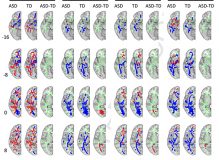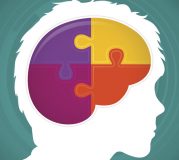
Carper, R.A., Treiber, J.M., Yandall DeJesus, S. & Müller, R.-A. (2016) Reduced Hemispheric Asymmetry of White Matter Microstructure in Autism Spectrum Disorder. Journal of the American Academy of Child and Adolescent Psychiatry, 55(12), 1073-1080.
SDSU psychologists discover brain connections in people with autism show more symmetry between hemispheres.
By Michael Price
Divvying up tasks between the left and right hemispheres of the brain is one of the hallmarks of typical brain development. The left hemisphere, for instance, is involved in analyzing specific details of a situation, while the right hemisphere is more important for integrating all the various streams of information coming into the brain.
A new study by neuropsychologists at San Diego State University suggests that in children and adolescents with autism spectrum disorder (ASD), the brains’ hemispheres are less likely to specialize one way or another. The finding gives further insight into how brain development in people with ASD contributes to the disorder’s cognitive characteristics.
The study, led by Ralph-Axel Müller, Ruth Carper and Jeffrey Treiber of SDSU’s Brain Development Imaging Lab, investigated how connections within the brain are organized differently in children and adolescents with ASD than in their typically developing peers. Using a magnetic resonance imaging (MRI) technique known as diffusion tensor imaging, the team studied the brains of 41 participants with ASD and 44 without, examining how densely connections formed within different regions of white matter in the brain.
They found that in typically developing young people, the right brain hemisphere had more densely packed connections than the left hemisphere.
“This fits with the idea that the right hemisphere has a more integrative function, bringing together many kinds of information,” the team wrote in a summary of their research.
However, in the participants with ASD, these brain connections were more symmetrically organized across both hemispheres. The findings are published in the December issue of the Journal of the American Academy of Child & Adolescent Psychiatry.
“The idea behind asymmetry in the brain is that there is a division of labor between the two hemispheres,” Müller said. “It appears this division of labor is reduced in people with autism spectrum disorder.”
That shift of specialization could manifest itself in what researchers refer to as “weak central coherence” — a concept best summed up in the idiom, “not seeing the forest for the trees.” Many people with ASD are very good at seeing details but have difficulty putting it all together into a cohesive narrative, he explained.
More research is needed to determine whether these brain-connection asymmetries cause this inability to cohesively assemble information, or are actually the result of it, Müller added. That and other future research will benefit from SDSU’s first imaging facility, which will play a central role within the Engineering and Interdisciplinary Sciences Complex, scheduled to open in 2018. The facility’s MRI machine will be installed early next year.
The study was also published by the Huffington Post.


